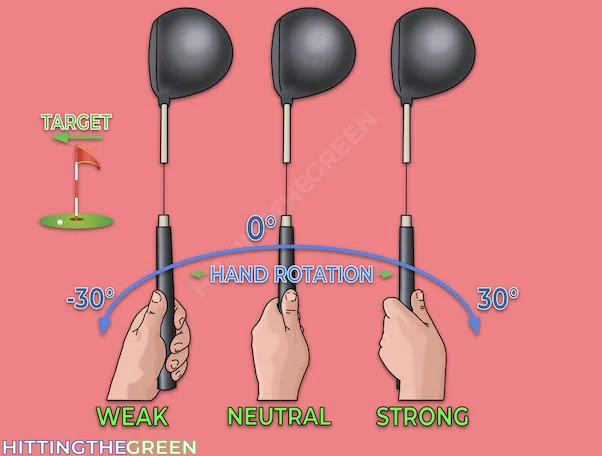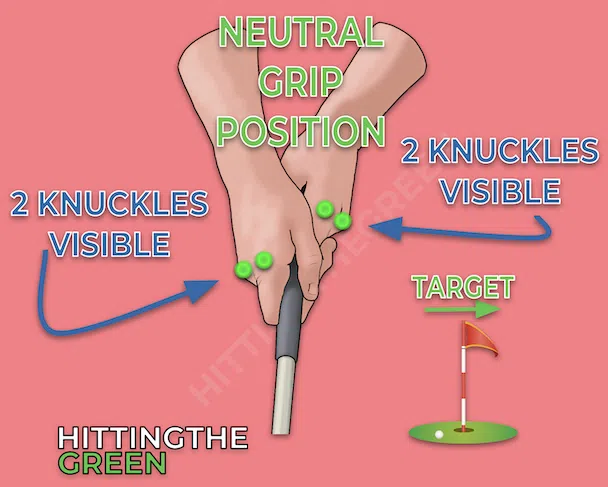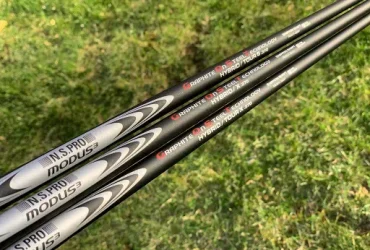Strong, Weak, or Neutral Grip? WHAT, WHY, and HOW
- What is a strong, weak, or neutral golf grip?
- Which grip position should you use?
- How does grip position affect your golf swing, distance, and accuracy?
- Which grip position should you use to fix issues like slices and hooks?
If you’ve asked any of these questions, you’re in the right place. We’ve created the ultimate resource for learning about grip position (strong, weak, and neutral grips) with all the pictures, facts, and tips you’ll ever need!
Contents
Grip Position Defined
Golf grip position is the placement and rotation of your hands on your golf club. Grip position can also be referred to as “grip rotation” and “grip direction”. There are three main grip positions:
- Strong
- Neutral
- Weak
What’s the Difference?: Strong, Neutral, and Weak Defined
Strong Grip Position
In a strong grip position, your hands are rotated around the club away from the target and toward your trailing side. This rotation of the hands around the club should be between 15 and 30 degrees away from your target. The hand rotation in a strong rip is sometimes called a clockwise rotation.
The rotation of the hands in a strong grip position will cause the “V”s where your thumbs and index fingers meet pointing toward your trailing shoulder (the right shoulder for most golfers).
Another difference between grip positions is how many knuckles are visible on each hand when viewed from the front. In a strong grip position, 2 or 3 knuckles of the lead/target-side hand will be visible and 1 or 2 knuckles of the trailing-side hand will be visible.
Neutral Grip Position
In a neutral grip position your hands are not rotated (0 degree rotation) around the club toward or away from the target.
In a neutral grip position the “V”s (where your thumbs and index fingers meet) point toward your chin.
In a neutral grip position, 2 knuckles of the lead/target-side hand and 2 knuckles of the trailing-side hand will be visible when viewed straight on from the front.
Weak Grip Position
In a weak grip position, your hands are rotated around the club toward your target and away from the trailing side of your body. This rotation should be between 15 and 30 degrees toward your target. The hand rotation in a weak grip is sometimes called a counter-clockwise rotation.
The rotation of the hands in a weak grip position will cause the “V”s where your thumbs and index fingers meet pointing toward your target-side shoulder (the left shoulder for most golfers).
Another difference between grip positions is how many knuckles are visible on each hand when viewed from the front. In a weak grip position, 2 or 3 knuckles of the trailing hand will be visible and 1 or 2 knuckles of the target-side hand will be visible.
Strong vs. Neutral vs. Weak: Quick Comparison
| Strong Grip | Neutral Grip | Weak Grip | |
|---|---|---|---|
| Hands Rotated Toward | Trailing Side | Neither | Target Side |
| Rotation (degrees) | 15° to 30° | 0° | -15° to -30° |
| “V” Points Toward | Trailing Shoulder | Chin | Target-side Shoulder |
| Visible Knuckles (Target-side Hand) | 2 or 3 knuckles | 2 knuckles | 1 or 2 knuckles |
| Visible Knuckles (Trailing Hand) | 1 or 2 knuckles | 2 knuckles | 2 or 3 knuckles |
| Recommended Experience Level | Intermediate+ | Beginner+ | Intermediate+ |
| Good for Fixing* | Slice* | N/A | Hook* |
*Hooks and slices are the result of the angle of the club face at the moment of contact. Grip position plays a role in this angle, but it is not the only factor. Other important factors to consider are swing release action, location of the golf ball in your stance, and the action of your trailing hand.
Grip Positions: Advantages & Disadvantages
Strong Grip Position
Advantages
- Eliminates a slice*
- Reduces topping of the ball
- Enables putting right-to-left spin on ball
- Helps to fix a swing that is too “inside-to-out”
- Eases turning over of club
- starting at impact and continuing into swing follow-through
Disadvantages
- Increases risk of hooking a shot
- Decreases ability to add much loft (height) to shots
- Reduces ability to put backspin on the golf ball
- Ball will bounce and roll for longer distances
Who Should Use a Strong Grip?
The strong grip should be used by golfers who are trying to eliminate a slice, golfers who frequently “top” the ball, and golfers who struggle to turn over the club as part of the swing release. For experienced, high-skill golfers, the strong grip can also be used to put right-to-left spin on the ball, so it’s great for hitting draw shots.
Neutral Grip Position
Advantages
- Simplifies relationship between (1) motion of arms and wrists and (2) motion and position of club face
- Increases accuracy (especially for beginners and average golfers)
- Eases “shaping” of shots (draws, pulls, pushes, and fades) for advanced golfers
Disadvantages
- Feels unnatural or uncomfortable for some golfers
Who Should Use a Neutral Grip?
The neutral grip is especially good for beginners. Why? It helps establish good fundamentals.
Becoming familiar with the neutral grip will give a beginner golfer a solid feel for grip position and the role grip position plays in a good golf swing. A neutral grip keeps things simple for beginners, and it is the grip position that tends to produce the longest and most accurate shots.
A neutral grip isn’t just for beginners. In fact, a neutral grip is great for advanced, low handicap golfers who need to shape their shots.
Weak Grip Position
Advantages
- Eliminates a hook*
- Enables putting backspin on ball
- Reduces bounce and roll distances
- Reduces role of wrists in swing mechanics, letting big muscles do more work
Disadvantages
- Decreases distance
- Because it tends to reduce club head speed
- Reduces accuracy, especially for beginners
- Increases risk of slicing a shot
- Makes swing release more difficult for many golfers
Who Should Use a Weak Grip?
The weak grip can be used by golfers who are looking to eliminate a hook from their game, golfers who want to put more backspin on the ball, and golfers whose swing tends to overemphasize the action of their wrists.
The weak grip isn’t great for beginners, but can be very useful for intermediate to advanced golfers who are more focused on shape and control of shots, as opposed to mastering the basics.
Distance and Accuracy: Strong vs. Neutral vs. Weak Grip Positions
A recent study published in the Journal of Sports Sciences examined the effect of grip position on shot outcomes. Their research found the following:
| Strong Grip | Neutral Grip | Weak Grip | |
|---|---|---|---|
| Accuracy** | 🥈 25 yards | 🏆 20 yards | 🥉 33 yards |
| Distance† | 🥈 194 yards | 🏆 195 yards | 🥉 165 yards |
| Club Head Speed†† | 🏆 85 mph | 🏆 85 mph | 🥉 81 mph |
**Average “horizontal” accuracy – how far, in yards, to the left or right of the target the shot landed, lower number is better
†Average “vertical” distance – how far, in yards, the ball traveled from tee to final stopping position, higher number is better
††Average speed of the head of the club at moment of impact, in miles per hour, higher number is better
Interpretation
Shots with a neutral grip produce the best distance and accuracy! Drives using the neutral and strong grip positions travel about 18% further than drives struck with a weak grip. Shots with neutral grip are 25% more accurate than shots hit with strong grip and 65% more accurate than shots hit with a weak grip! In other words, the neutral grip is the superior grip.
While this study is very useful, we should be careful in drawing broad conclusions.
Why?
- The study only covered 28 golfers who each hit 9 shots
- Not a lot of data!
- Study only used the driver club
- Conclusions might not apply to other clubs
In any case, there seems to be decent evidence that a neutral grip will be best for beginner and average golfers.
Our conclusion? The best grip will vary depending on the skill and experience of the golfer and the desired outcome of the shot. Weak and strong grips can be very useful in any circumstances.
But, on average, a neutral grip tends to produce superior results for most golfers.
Grip Position (Strong vs. Neutral vs. Weak) Common Questions
What is grip position in golf?
Golf grip position is the placement and rotation of your hands on your golf club. Grip position can also be referred to as “grip rotation” and “grip direction”. There are three main grip positions: strong, neutral, and weak.
Is a strong grip good in golf?
Yes. But also, it depends.
A strong grip can be used to eliminate a slice, stop topping the ball, put right-to-left spin on the ball, and make turn over the club easier.
But, these are all things that are more important for intermediate and advanced golfers to focus on.
Is a weak grip bad in golf?
Not necessarily.
A weak grip isn’t great for beginners because it makes it harder to focus on the fundamentals of the golf swing.
But, a weak grip can be used to eliminate a hook, put backspin on ball, reduce bounce and roll distance, reduce the role of wrists in swing mechanics, and let your big muscles do more of the work.
Is a weak grip good in golf?
Yes! But also, it depends.
A weak grip tends to be best for intermediate and advanced golfers, but not so great for beginners.
More experienced golfers can use the weak grip position to eliminate a hook, put backspin on ball, reduce bounce and roll distance, reduce the role of wrists in swing mechanics, and let the big muscles do more of the work.
Is a strong or weak grip better?
Neither grip is better. It all depends on what you’re trying to accomplish.
A neutral grip is best for beginners.
A strong grip can be used to eliminate a slice, stop topping the ball, put right-to-left spin on the ball, and make turn over the club easier.
A weak grip can be used to eliminate a hook, put backspin on ball, reduce bounce and roll distance, reduce the role of wrists in swing mechanics, and let your big muscles do more of the work.
Determine what you’re trying to accomplish. Then, experiment and practice with the appropriate grip. You’ll figure out which is best for you!
What is the most effective golf grip?
It depends! A neutral grip is most effective for beginners.
A strong grip is good for intermediate and advanced golfers. It can be used to eliminate a slice, stop topping the ball, put right-to-left spin on the ball, and make turn over the club easier.
A weak grip is good for intermediate and advanced golfers. It can be used to can be used to eliminate a hook, put backspin on ball, reduce bounce and roll distance, reduce the role of wrists in swing mechanics, and let your big muscles do more of the work.
What does a neutral golf grip do?
A neutral grip gives you a solid feel for grip position and the role grip position plays in a good golf swing. It keeps things simple.
The neutral grip position tends to produce the longest and most accurate shots.
It also simplifies relationship between (1) motion of arms and wrists and (2) motion and position of club face. It also eases “shaping” of shots (draws, pulls, pushes, and fades) for advanced golfers.
Holding a golf club correctly can make or break your game. You’ll be surprised…[KEEP READING]
Putting trouble? These 6 grip techniques can help you sink that next 8-footer. Remember: the hands are your body’s only…[KEEP READING]
The 7 best tips for holding your golf club! Easy and simple game improveme…[KEEP READING]
Conclusion
There you have it! Everything you ever wanted to know about grip position.
Remember, there is no “correct” or “best” grip position. Each has its place in the game of golf.
It all depends on your skill, experience, and goals.
Now get out there and learn, play, and improve!















